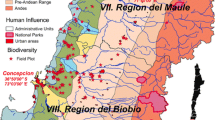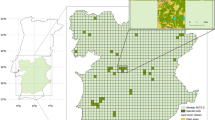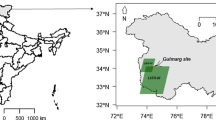Abstract
Present study attempts to utilise the spatial information from IRS-IC LISS-III satellite data, through, tie use of Semivartogram apprqatfu for analyzing the overstorey. diversity In forest stands, Semivariance has been calculated for all the pixels in I5x15 pixel window for each of the forest stand using digital numbers from near infrared channel Variation in semivariance has been correlated to stand density and species composition. Analysis of averaged semivariance for overall diversity of forest stands suggested, decreasing semi variance in the order, mixed dry (feciduous forests, mixed scrub forests followed by dry deciduous forest Semivariance has been found to be highly Correlated to tree density (R2 = 0.96) suggesting semivariograms as one of the measures for studies on tree density, canapy cover and diversity patterns.
Similar content being viewed by others
References
Bowers W W, Franklin S E, Hudak J and McDermid G J (1994). Forest structural damage analysis using image Semivariance. Can. J. Remote Sensing, 20(l):28–36.
Bijlsma R J (1993). The characterization of natural vegetation using first-order and texture measurements in digitized, colour infrared photography. Int. J. Remote Sensing, 14(8): 1547–1562.
Champion H G and Seth S K (1968). A revised survey of forest types of India, New Delhi Govt. Publication, pp. 102–108.
Chauvet M and Oliver L (1993). La biodiversite Enjeu planetaire, preserver notre patrimoine genetique. Editions Sang de laTene. Paris, pp. 103–108.
Cohen Warren B, Thomas Spies and Gay A Bradshaw (1990). Semivariograms of Digital Imagery for analysis of Conifer Canopy Structure, Remote Sensing Env., 34:167–178.
Curran P J (1988). The Semivariogram in remote sensing, Remote Sensing Env., 32:493–507.
Curran P J and Dungan J L (1989). Estimation of signal-to-noise: a new procedure applied to AVIRIS data. IEEE Trans. Geosci. Remote Sens., 27:620–628.
Delcourt H R and Delcourt P A (1988). Quaternary Landscape Ecology: Relevant scales in space and time. Landscape Ecology, 2:45–61.
Formon R T T and Godron M (1986). Landscape Ecology. John Wiley and Sons, New York, pp. 92–98.
Franklin J, Logan T, Woodcock C E and Strahler A H (1986). Coniferous forest classification and inventory using LANDSAT and Digital Terrain Data. IEEE Trans. Geosci. Remote Sens., 24:139–149.
Getis A and Franklin J (1987). Second order neighbourhood analysis of mapped point patterns. Ecology, 69:473–77.
Hannah L and Bowels I (1995). Letters: Global priorities. Bioscience, 45:122.
Haralick R M and Shanmugan K S (1974). Combined spectral and spatial processing of ERTS Imagery Data. Remote Sensing Env., 13:3–13.
Hunsaker C T and Carpenter D E (1990). Ecological indicators for the environmental monitoring and assessment program, EPA 600/3 90/060. (Research Triangle Park. NC: U.S. Environmental Protection Agency, Office of Research and Development), pp. 86–89.
Journel A G and Huijbregts Ch J (1978). Mining Geostatistics. Academic Press, New York, pp. 14–33.
Lovejoy T E (1980a). Foreword. In Conservation Biology: An Evolutionary — Ecological Perspective (ed. M.E. Soule & B.A. Wilcox), Sunderland, Massachussets: Sinaver associates, pp. 5–9.
Lovejoy T E (1980b). Changes in Biological Diversity. In the global 2000 report to the president (The technical report) (ed. G.O. Barney), Harmondsworth Penguin books, 2:327–332.
MC Neely J A, Miller K R, Reid W, Mittermeier R and Werner T (1990). Conserving the world’s biological diversity. IUCN, WRI, World Bank, WWF- US, C.I. Washington DC.
Ord J K (1979). Time series and spatial patterns in ecology. In spatial and temporal analysis in ecology, Statistical Ecology Series. 8 (eds. R.M. Cormack and J.K. Ord), Fairland, Md: International cooperative publishing house, pp. 1–94.
Ramstein G and Raffy M (1989). Analysis of the structure of radiometric remotely sensed images, Int. J. Remote Sens., 10:1049–1073.
Ried W V and Miller K R (1989). Keeping options alive. World Resources Institute, Washington DC, pp. 82–89.
Singh I J and Roy P S (1990). Growing stock estimation through stratified sampling on satellite remote sensing data. J. Indian Soc. Rem. Sens., 18(1–2):29–42.
Turner J S, Robert V O Neill, Walt Conley, Conley R Marcha and Hope C Humphries (1990). Pattern and Scale: Statistics for Landscape Ecology. In bk. Quantitative Methods in Landscape Ecology (ed). Monica G. Turner and Robert H Gardner. Springer Verlag., New York, pp. 18–48.
Wald L (1989). Some examples of the use of structure functions in the analysis of satellite images of the ocean. Photogramm. Engg. & Remote Sensing, 55:1487–1490.
Webster R, Curran P J and Munden J W (1989). Spatial correlation in reflected radiation from the ground and its implications for sampling and mapping by ground-based radiometry. Remote Sens. Env., 29:67–78.
Whittaker R H (1956). Vegetation of the Great Smoky Mountains. Ecological Monographs. 26:1–80.
Whittaker R H (1960). Vegetation of Siskiyou Mountains, Oregon and California, Ecological Monographs, 30:279–338.
Woodcock C E, Strahler A H (1987). The factor of scale in remote sensing. Remote Sensing Env., 21:311–332.
Author information
Authors and Affiliations
About this article
Cite this article
Prasad, V.K., Rajagopal, T., Kant, Y. et al. Studies on biodiversity using semivariogram approach from IRS-IC LISS-III data. J Indian Soc Remote Sens 26, 103–112 (1998). https://doi.org/10.1007/BF03026667
Received:
Revised:
Issue Date:
DOI: https://doi.org/10.1007/BF03026667




